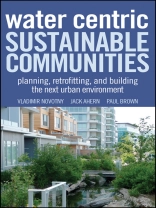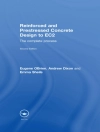The current literature compartmentalizes the complex issue of water and wastewater into its discrete components; technology, planning, policy, construction, economics, etc. Considered from the perspective of sustainability, however, water in the urban environment must be approached as a single resource that can be continuously reused and recycled. This book will be the first to capture all of the current work on this idea in a single, integrated, plan for designing the water-centric cities of the future. From new construction to the retrofitting of existing systems, this book presents the case for a new urban relationship to water, one with a more sustainable connection to the environment and the hydrological cycle. Through case studies of successfully planned and built systems around the world, the book will educate the reader about the need for a new approach to urban water management, and make the case that these changes are not only possible but imperative.
表中的内容
Preface xii
I Historic Paradigms of Urban Waterstormwater Wastewater Management and Drivers for Change 1
I.1 Introduction 1
I.2 Historic Paradigms: From Ancient Cities to the 20th Century 5
I.2.1 First Paradigm 8
I.2 Second Paradigm 9
I.2.3 Third Paradigm 15
I.2.4 Fourth Paradigm 25
I.2.5 The Impact of Automobile Use 32
I.2.6 Urban Sprawl 38
I.2.7 The Rise of New Great Powers Competing for Resources 40
I.3 Drivers for Change towards Sustainability 42
I.3.1 Population Increases and Pressures 44
I.3.2 Water Scarcity Problems and Flooding Challenges of Large Cities 49
I.3 Greenhouse Emissions and Global Warming Effects 51
I.3.4 Aging Infrastructure and the Need to Rebuild and Retrofit 59
I.3.5 The Impossibility of Maintaining the Status Quo and Business as Usual 60
I.4 The 21st Century and Beyond 65
References 68
II Urban Sustainability Concepts 72
II.1 The Vision of Sustainability 72
II.2 The Sustainability Concept and Definitions 73
II.2.1 A New (Fifth) Paradigm Is Needed 73
II.2 Definition of Pollution 76
II.2.3 Sustainability Definitions 80
II.2.4 Economic versus Resources Preservation Sustainability 82
II.2.5 Sustainability Components 85
II.2.6 The Environment and Ecology 87
II.2.7 Living within the Limits in the Urban Landscape 90
II.2.8 The Economy 94
II.3 Towards the Fifth Paradigm of Sustainability 97
II.3.1 Emerging Sustainable Urban Water Stormwater Used Water Systems 99
II.3.2 Triple Bottom Line—Life Cycle Assessment (tbl—lca) 104
II.3.3 Water Reclamation and Reuse 106
II.3.4 Restoring Urban Streams 108
II.3.5 Stormwater Pollution and Flood Abatement 110
II.3.6 Urban Landscape 113
II.4 Cities of the Future—Water Centric Ecocities 114
II.4.1 Drainage and Water Management 114
II.4.2 Microscale Measures and Macroscale Watershed Goals 116
II.4.3 Integrated Resource Management Clusters—Ecoblocks of the Cities of the Future 120
II.4 Interconnectivity of Clusters—Spatial Integration 123
II.5 Ecocity Ecovillage Concepts 124
References 129
III Planning and Design for Sustainable and Resilient Cities: Theories, Strategies, and Best Practices for
Green Infrastructure 135
III.1 Introduction 135
III.1 Achieving Sustainability 135
III.1.2 Sustainability through Urban Planning and Design 137
III.2 Ecosystem Services 138
III.2.1 Concepts 138
III.2 The Non-Equilibrium Paradigm 141
III.3 Planning for Resilient and Sustainable Cities 143
III.3.1 Ecosystem Service Goals and Assessments 143
III.3.2 Resilience Strategies 144
III.3 Scenario Planning 155
III.3.4 Transdisciplinary Process 157
III.3.5 Adaptive Planning 157
III.4 Best Practices for Green Infrastructure 158
III.4.1 SEA Street Seattle 159
III.4.2 Westergasfabriek Park, Amsterdam 162
III.4.3 Staten Island Blue Belt, New York162
III.4.4 Ecostaden (Ecocities): Augustenborg Neighborhood and Western Harbor, Malmö, Sweden 164
III.5 Discussion 170
References 171
IV Stormwater Pollution Abatement and Flood Control—stormwater as a Resource 177
IV.1 Urban Stormwater—A Problem or an Asset? 177
IV.1 Problems with Urban Stormwater 177
IV.1.2 Current Urban Drainage 182
IV.1.3 Urban Stormwater Is an Asset and a Resource 184
IV.1.4 Low Impact Development (LID) 186
IV.2 Best Management Practices to Control Urban Runoff for Reuse 189
IV.2.1 Soft Surface Approaches 190
IV.2.2 Ponds and Wetlands 201
IV.2.3 Winter Limitations on Stormwater Management and Use 212
IV.2.4 Hard Infrastructure 216
IV.2.5 ID Urban Drainage—A Step to the Cities of the Future 218
References 222
V Water Demand and Conservation 228
V.1 Water Use 228
V.1 Water on Earth 228
V.1.2 Water Use Fundamentals 232
V.1.3 Municipal Water Use in the U.S. and Worldwide 235
V.1.4 Components of Municipal Water Use 239
V.1.5 Virtual Water 240
V.2 Water Conservation 241
V.2.1 Definition of Water Conservation 241
V.2 Residential Water Use 241
V.2.3 Commercial and Public Water Use and Conservation 249
V.2.4 Leaks and Other Losses 251
V.3 Substitute and Supplemental Water Sources 252
V.3.1 Rainwater Harvesting (RWH) 252
V.3.2 Gray Water Reclamation and Reuse as a Source of New Water 256
V.3 Desalination of Seawater and Brackish Water 260
V.3.4 Urban Stormwater and Other Freshwater Flows as Sources of Water 266
References 268
VI Water Reclamation and Reuse 272
VI. 1 Introduction 272
VI.2 Water Reclamation and Reuse 274
VI.2.1 The Concept 274
VI.2 Reclaiming Rainwater and Stormwater 279
VI.2.3 Water-Sewage-Water Cycle—Unintended Reuse 280
VI.2.4 Centralized versus Decentralized Reclamation 281
VI.2.5 Cluster Water Reclamation Units 282
VI.3 Water Quality Goals and Limits for Selecting Technologies 286
VI.3.1 Concepts 286
VI.3.2 Landscape and Agricultural Irrigation 289
VI.3 Urban Uses Other Than Irrigation and Potable Water Supply 293
VI.3.4 Potable Reuse 297
VI.3.5 Groundwater Recharge 300
VI.3.6 Integrated Reclamation and Reuse—Singapore 304
References 308
VII Treatment and Resource Recovery Unit Processes 311
VII.1 Brief Description of Traditional Water and Resource Reclamation Technologies 311
VII.1 Basic Requirements 311
VII.1.2 Considering Source Separation 312
VII.1.3 Low-Energy Secondary Treatment 315
VII.1.4 New Developments in Biological Treatment 324
VII.2 Sludge Handling and Resource Recovery 329
VII.2.1 Types of Solids Produced in the Water Reclamation Process 331
VII.2 A New Look at Residual Solids (Sludge) as a Resource 334
VII.3 Nutrient Recovery 336
VII.4 Membrane Filtration and Reverse Osmosis 339
VII.5 Disinfection 340
VII.6 Energy and GHG Emission Issues in Water Reclamation Plants 346
VII.7 Evaluation and Selection of Decentralized Water Reclamation Technologies 348
VII.7.1 Closed Cycle Water Reclamation 348
References 354
VIII Energy and Urban Water Systems—towards Net Zero Carbon Footprint 358
VIII. 1 Interconnection of Water and Energy 358
VIII.1 Use of Water and Disposal of Used Water Require Energy and Emit GHGs 358
VIII.1.2 Greenhouse Gas Emissions from Urban Areas 360
VIII.1.3 The Water-Energy Nexus on the Regional and Cluster Scale 362
VIII.1.4 Net Zero Carbon Footprint Goal for High-Performance Buildings and Developments 365
VIII.2 Energy Conservation in Buildings and Ecoblocks 371
VIII.2.1 Energy Considerations Related to Water 371
VIII.2 Heat Recovery from Used Water 379
VIII.3 Energy from Renewable Sources 380
VIII.3.1 Solar Energy 380
VIII.3.2 Wind Power387
VIII.4 Energy from Used Water and Waste Organic Solids 392
VIII.4.1 Fundamentals 392
VIII.4.2 Biogas Production, Composition, and Energy Content 394
VIII.4.3 Small and Medium Biogas Production Operations 397
VIII.4 Anaerobic Upflow Reactor 398
VIII.5 Direct Electric Energy Production from Biogas and Used Water 399
VIII.5.1 Hydrogen Fuel Cells 400
VIII.5.2 Microbial Fuel Cells (MFC) 403
VIII.5.3 Harnessing the Hydraulic Energy of Water Used Water Systems 406
VIII.6 Summary and a Look into the Future 408
VIII.6.1 A New Look at the Used Water Reclamation Processes 408
VIII.6.2 Integrated Resource Recovery Facilities 411
VIII.7 Overall Energy Outlook—Anticipating the Future 416
VIII.7.1 A Look into the Future 20 or More Years Ahead 416
VIII.7.2 Is Storage a Problem? 421
References 2
IX Restoring Urban Streams 427
IX.1 Introduction 427
IX.1 Rediscovering Urban Streams 427
IX.1.2 Definitions 437
IX.2 Adverse Impacts of Urbanization to Be Remedied 438
IX.2.1 Types of Pollution 438
IX.2 Determining Main Impact Stressors to Be Fixed by Restoration 443
IX.2.3 Effluent Dominated and Effluent Dependent Urban Water Bodies 447
IX.3 Water Body Restoration in the Context of Future Water Centric (Eco) Cities 453
IX.3.1 Goals 453
IX.3.2 Regionalized versus Cluster-Based Distributed Systems 455
IX.3 New Developments and Retrofitting Older Cities 457
IX.4 Summary and Conclusions 476
References 479
X Planning and Management of Sustainable Future Communities 482
X.1 Integrated Planning and Management 482
X.1 Introduction 482
X.1.2 Footprints 484
X. 2 Urban Planning 487
X.2.1 Ecocity Parameters and Demographics—Population Density Matters 488
X. 3 Integrated Resources Management (IRM) 493
X.3.1 Sustainability 493
X. 4 Clusters and Ecoblocks—Distributed Systems 497
X.4.1 The Need to Decentralize Urban Water Stormwater Used Water Management 497
X.4.2 Distribution of Resource Recovery, Reclamation and Management Tasks 499
X.4.3 Cluster Creation and Size 503
X.4 Types of Water Energy Reclamations and Creation of a Sustainable Urban Area 505
X. 5 System Analysis and Modeling of Sustainable Cities 514
X.5.1 Complexity of the System and Modeling 514
X.5.2 Triple Bottom Line (TBL) Assessment 518
X. 6 Institutions 525
X.6.1 Institutions for Integrated Resource Management 526
X.6.2 Enhanced Private Sector 532
X.6.3 Achieving Multibenefit System Objectives 533
References 535
XI Ecocities: Evaluation and Synthesis 539
XI.1 Introduction 539
XI.2 Case Studies 542
XI.2.1 Hammarby Sjöstad, Sweden 542
XI.2 Dongtan, China 549
XI.2.3 Qingdao (China) Ecoblock and Ecocity 556
XI.2.4 Tianjin (China) 560
XI.2.5 Masdar (UAE) 566
XI.2.6 Treasure Island (California, U.S.) 573
XI.2.7 Sonoma Mountain Village (California, U.S.) 579
XI.2.8 Dockside Green 585
XI.3 Brief Summary 588
References 590
Appendix 595
Index 597
关于作者
Vladimir Novotny is Professor at Northeastern University in Boston, Massachusetts, and Emeritus Professor at Marquette University in Milwaukee, Wisconsin. He is also President of Aqua Nova, LLC.
Jack Ahern is Professor of Landscape Architecture and Regional Planning at the University of Massachusetts in Amherst, Massachusetts.
Paul Brown is Executive Vice President at CDM in Cambridge, Massachusetts, and is also Technical Director of the Neysadurai Centre for Integrated Water Resources and Urban Planning in Singapore.












